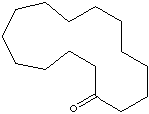PRODUCT IDENTIFICATION

H.S. CODE
TOXICITY
CLASSIFICATION
PHYSICAL AND CHEMICAL PROPERTIES
MELTING POINT
SOLUBILITY IN WATER
REFRACTIVE INDEX
GENERAL DESCRIPTION & APPLICATIONS
- Nitro Class
- Musk Xylol (2,4,6-Trinitro-1,3-dimethyl-5-tert-butylbenzene, CAS RN: 81-15-2 )
- Musk Ketone (4'-tert-Butyl-2',6'-dimethyl-3',5'-dinitroacetophenone, CAS RN: 81-14-1 )
- Musk Ambrette (4-tert-Butyl-2,6-dinitro-3-methoxytoluene, CAS RN: 83-66-9)
- Musk Tibetene (5-tert-Butyl-1,2,3-trimethyl-4,6-dinitrobenzene, CAS RN: 145-39-1 )
- Musk Moskene (2,3-Dihydro-1,1,3,3,5-pentamethyl-4,6-dinitro-1H-Indene, CAS RN: 116-66-5)
- Polycyclic Musk Class
- Musk GX (1,3,4,6,7,8-Hexahydro-4,6,6,7,8,8-hexamethyl-cyclopenta-gamma-2-benzopryan, CAS RN: 1222-05-5 )
- 1-(5,6,7,8-Tetrahydro-3,5,5,6,8,8-hexamethyl-2-naphthyl)ethan-1-one (CAS RN: 1506-02-1)
- Celestolide (4-Acetyl-6-t-butyl-1,1-dimethylindan, CAS RN: 13171-00-1)
- 5-Acetyl-1,1,2,3,3,6-hexamethyl indan (CAS RN: 15323-35-0)
- 5-Acetyl-3-isopropyl-1,1,2,6-tetramethylindane (CAS RN: 68140-48-7)
- 1,1,4,4-Tetramethyl-6-ethyl-7-acetyl-1,2,3,4-tetrahydronaphthalene (CAS RN: 88-29-9)
- 3,4,6,7,8,9-Hexahydro-4,6,6,9,9-pentamethyl-1H-naphtho[2,3-C]pyran (CAS RN: 1922-67-4)
- 2,4-Dimethyl-2-(1,1,4,4-tetramethyltetralin-6-yl)-1,3-dioxolane (CAS RN: 131812-67-4)
- Macrocyclic Class
- Muscone (3-Methylcyclopentadecanone CAS RN: 541-91-3)
- Exaltone (Cyclopentadecanone, CAS RN: 502-72-7)
- Cervolide (1,6-Dioxacycloheptadecan-7-one, CAS RN: 6707-60-4)
- Musk Ambrettolide ((Z)-Oxacycloheptadec-8-en-2-one, CS RN: 123-69-3)
- Exaltolide (Oxacyclohexadecan-2-one, CAS RN: 106-02-5)
- Musk T (1,4-Dioxacycloheptadecane-5,17-dione, CAS RN: 105-95-3)
- Ambrettolide (Oxacycloheptadec-10-en-2-one, CAS RN: 28645-51-4)
- Civetone ((Z)-9-Cycloheptadecen-1-one, CAS RN: 542-46-1)
- Cyclopentadecanone (CAS RN: 502-72-7)
- Ambretone (5-Cyclohexadecenone, CAS RN:37609-25-9)
- Musk R1 (11-Oxahexadecanolide, CAS RN: 3391-83-1 )
- 1,4-Dioxacyclohexadecane-5,16-dione (CAS RN: 54982-83-1)
APPEARANCE
OTHER INFORMATION